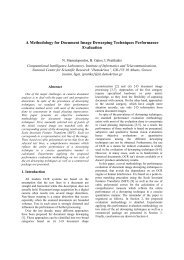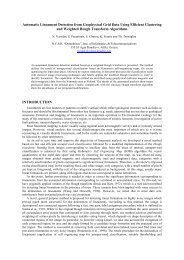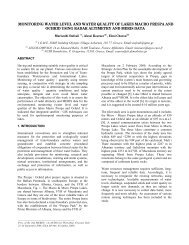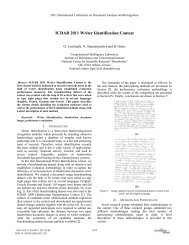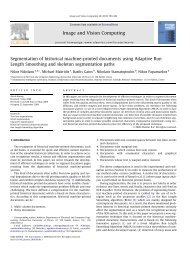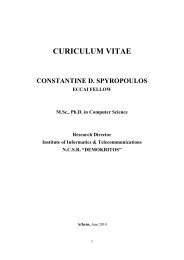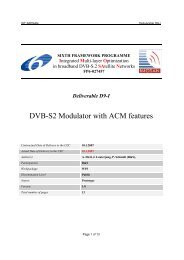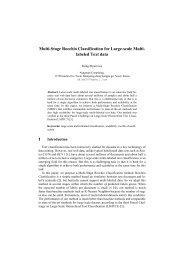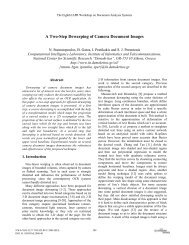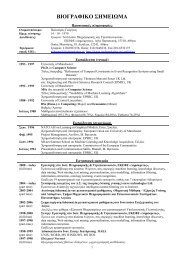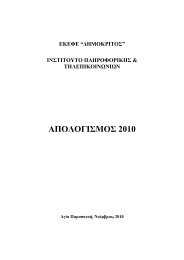TMS320C6713B Floating-Point Digital Signal Processor (Rev. A)
TMS320C6713B Floating-Point Digital Signal Processor (Rev. A)
TMS320C6713B Floating-Point Digital Signal Processor (Rev. A)
Create successful ePaper yourself
Turn your PDF publications into a flip-book with our unique Google optimized e-Paper software.
timing requirements for reset †‡ (see Figure 49)<br />
RESET TIMING<br />
SPRS294 − OCTOBER 2005<br />
NO.<br />
PYP-200,-225<br />
GDP/ZDP -225, -300<br />
PYPA -167, -200 UNIT<br />
GDPA/ZDPA −200<br />
MIN MAX<br />
1 tw(RST) Pulse duration, RESET 100 ns<br />
13 tsu(HD) Setup time, HD boot configuration bits valid before RESET high§ 2P ns<br />
14 th(HD) Hold time, HD boot configuration bits valid after RESET high§ 2P ns<br />
† P = 1/CPU clock frequency in ns. For example, when running parts at 300 MHz, use P = 3.3 ns.<br />
‡ For the C6713B device, the PLL is bypassed immediately after the device comes out of reset. The PLL Controller can be programmed to change<br />
the PLL mode in software. For more detailed information on the PLL Controller, see the TMS320C6000 DSP Phase-Lock Loop (PLL) Controller<br />
Peripheral Reference Guide (literature number SPRU233).<br />
§ The Boot and device configurations bits are latched asynchronously when RESET is transitioning high. The Boot and device configurations bits<br />
consist of: HD[14, 8, 4:3].<br />
switching characteristics over recommended operating conditions during reset (see Figure 49)<br />
NO.<br />
2 td(RSTH-ZV)<br />
PARAMETER<br />
Delay time, external RESET high to internal reset high and<br />
all signal groups valid#|| CLKMODE0 = 1<br />
PYP-200,-225<br />
GDP/ZDP -225, -300<br />
PYPA-167, -200<br />
GDPA/ZDPA −200<br />
MIN MAX<br />
512 x CLKIN<br />
period<br />
3 td(RSTL-ECKOL) Delay time, RESET low to ECLKOUT high impedance 0 ns<br />
4 td(RSTH-ECKOV) Delay time, RESET high to ECLKOUT valid 6P ns<br />
5 td(RSTL-CKO2IV) Delay time, RESET low to CLKOUT2 high impedance 0 ns<br />
6 td(RSTH-CKO2V) Delay time, RESET high to CLKOUT2 valid 6P ns<br />
7 td(RSTL-CKO3L) Delay time, RESET low to CLKOUT3 low 0 ns<br />
8 td(RSTH-CKO3V) Delay time, RESET high to CLKOUT3 valid 6P ns<br />
9 td(RSTL-EMIFZHZ) Delay time, RESET low to EMIF Z group high impedance|| 0 ns<br />
10 td(RSTL-EMIFLIV) Delay time, RESET low to EMIF low group (BUSREQ) invalid|| 0 ns<br />
11 td(RSTL-Z1HZ) Delay time, RESET low to Z group 1 high impedance|| 0 ns<br />
12 td(RSTL-Z2HZ) Delay time, RESET low to Z group 2 high impedance|| 0 ns<br />
P = 1/CPU clock frequency in ns.<br />
Note that while internal reset is asserted low, the CPU clock (SYSCLK1) period is equal to the input clock (CLKIN) period multiplied by 8. For<br />
example, if the CLKIN period is 20 ns, then the CPU clock (SYSCLK1) period is 20 ns x 8 = 160 ns. Therefore, P = SYSCLK1 = 160 ns while<br />
internal reset is asserted.<br />
# The internal reset is stretched exactly 512 x CLKIN cycles if CLKIN is used (CLKMODE0 = 1). If the input clock (CLKIN) is not stable when RESET<br />
is deasserted, the actual delay time may vary.<br />
|| EMIF Z group consists of: EA[21:2], ED[31:0], CE[3:0], BE[3:0], ARE/SDCAS/SSADS, AWE/SDWE/SSWE, AOE/SDRAS/SSOE and<br />
HOLDA<br />
EMIF low group consists of: BUSREQ<br />
Z group 1 consists of: CLKR0/ACLKR0, CLKR1/AXR0[6], CLKX0/ACLKX0, CLKX1/AMUTE0, FSR0/AFSR0, FSR1/AXR0[7],<br />
FSX0/AFSX0, FSX1, DX0/AXR0[1], DX1/AXR0[5], TOUT0/AXR0[2], TOUT1/AXR0[4], SDA0 and SCL0.<br />
Z group 2 consists of: All other HPI, McASP0/1, GPIO, and I2C1 signals.<br />
UNIT<br />
ns<br />
POST OFFICE BOX 1443 • HOUSTON, TEXAS 77251−1443<br />
121



